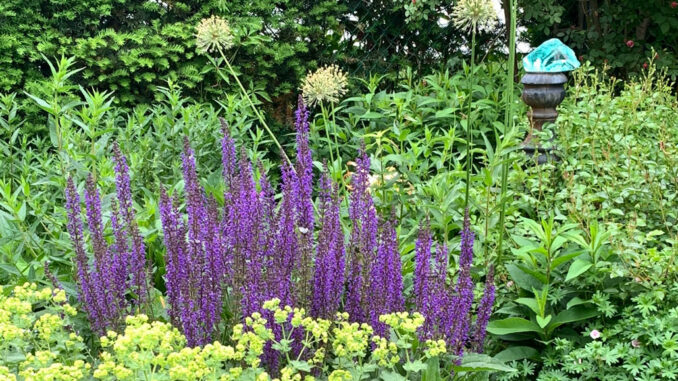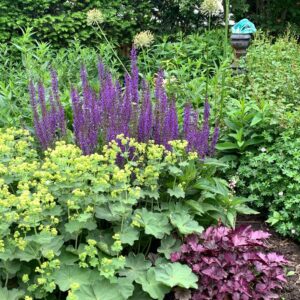
In the blink of an eye, our garden season has come to a rest, and the same goes for me. Honestly, I found this season exhausting with so much going on. It’s no wonder we forget and very the reason most gardeners keep a journal.
Now is a good time to look over those journals and remember. How did we do? What did we learn? Can we do better?
But there’s even more we can learn beyond our own yards. So, let’s look back at a few of the highlights (and lowlights) from the Leaside gardening year of 2022: good, bad, even ugly.

The good
This was the Year of the Garden, and even though we got a late start celebrating, the gardening year began with a lot more hope and an eagerness to do better.
In April, I wrote about dandelions and was overwhelmed by the favourable response. Who knew there were so many dandelion lovers in the ‘hood?
In June, the Leaside Garden Society brought back their in-person garden tour after two long years and we got to see some pretty amazing backyards. There were pollinator gardens, food gardens and even a ‘mini forest’ garden. It was a great opportunity to learn some really good gardening practices from of our local green thumbs.
We saw a lot more balconies come alive this year too, filled with flower boxes, vegetables, herbs and potted evergreens. Sky gardening is beginning to grow at last!
In August, I did a feature story about a new front yard pollinator garden that not only helped nature, it helped the gardener as well.
And for the annual Harvest Report in September, I shone a well-deserved light on volunteer gardeners at the St. Cuthbert’s Community Garden.
Yes, there was a lot of good gardening going on in Leaside this year.
The bad
It was both bad and sad when Davenport Garden Centre closed their Bayview location. I will miss the convenience and great selection of quality organic, native and neonic-free plants, along with their knowledgeable staff.
Back in July, I had a long conversation with Carla Rose (one of the owners) to get her take on this year’s garden season and find out what our local gardeners were buying.
“It was a strange season” Carla said. “People were buying much like they did in 2019. Maybe it was because of the cold spring, maybe people were just too busy. I don’t know. But it was like they just wanted a quick fix and needed some instant gratification.”
That statement broke my green heart because numbers don’t lie. During both spring and summer, Davenport’s Bayview location saw an increase in sales of annuals (in particular hanging baskets and pre-filled planters) while vegetables and herbs fell behind. Overall, annual flowers outperformed perennials. Interesting.
This year, the Bayview Leaside BIA planters were (once again) stuffed with exotic annuals including some Canna lilies that reached ginormous heights. With constant watering and steady fertilizing, our main street exploded with colourful annuals from spring to fall with three different installations. And all three displays received rave reviews from of our local shoppers and visitors alike.
But not from this Leaside gardener.
I’m not against using annual florals. These temporary plants can be a positive addition to a garden. When planted with untreated seeds, many of these florals can greatly assist in the production of healthy edible crops by inviting in pollinators and warding off harmful insects. At the same time, they can uplift our spirits with their colourful blooms.
My issues are more with the unsustainable practice of using these potted annual florals in extreme (like cake decorating) for no other reason than beautification. This increased demand is fueling a multibillion dollar industry that simply cannot exist without abusing an enormous amount of our precious resources. And that’s not good gardening practice.
Every one of these potted annuals has a huge environmental footprint and it’s apparent from beginning to end. Starting with a peat based soil, these plants require constant watering and use a tremendous amount of energy for both growing and transportation. But there’s more. Flower growers are not subject to the same regulatory conditions imposed on growers of edible crops. That means chemical fertilizers, pesticides and herbicides are extensively used in floriculture that can contaminate our soil and water as well as poison our pollinators. And there’s still more. Almost all of those plastic pots will ultimately end up in landfill.
To me, annual florals have become the horticultural equivalent to fast fashion.
Any garden practice that harms the environment should be considered bad. Right? Yet no matter how much information is out there, it’s clear some old habits die hard. Most of us are guilty of this to some degree and we all need to do better.
This year, the biggest of the bad was definitely the weather.
My garden journal shows me that for three years in a row, Leaside experienced a cold and late spring, followed by extreme heat, humidity and drought. Should we be getting used to this? Weather forecasters were useless with their predictions. There were days calling for rain (90%) and we didn’t see a drop. When it did rain (which was rare) even downtown got more rain than Leaside.
When it comes to weather, ‘record-breaking’ is starting to sound like a broken record.
The ugly
OK, calling a garden ugly is pretty harsh. But what would you call a biological dead zone?
A garden buddy of mine lives in a Leaside condo that overlooks a few ravine lots. I’ve never seen them, but it must be a special feeling to overlook a forest.
Unfortunately, this year, one of those backyards got a makeover and with a bird’s eye view, my friend watched in horror as all of the plants were removed. The deep slope was carved into tiered levels and a layer of something that looked like cement (more likely compacted limestone) was installed. Then it was all carpeted with artificial turf.
To me, the only thing worse than paving over paradise is to top it off with plastic grass!
Speaking of grass, lawns have never been well-suited to our area – even when rainfall patterns were somewhat normal. This year, many Leaside lawns began to show their true colours (many shades of brown) and it wasn’t pretty. With the high cost of water and with so little rain, many lawns were left to go dormant causing them to look more like coco mats rather than green carpets. For the few lawns that remained green, I could only imagine the amount of water used to keep them that way.
Very soon, a blanket of snow will cover every Leaside garden (good, bad and ugly) like a clean canvas awaiting the next masterpiece. I wonder. What will we create next year? Hopefully a lot more good!


